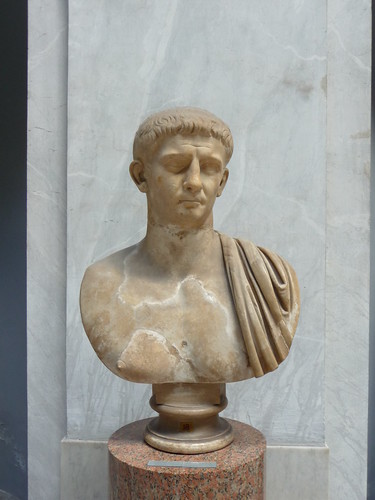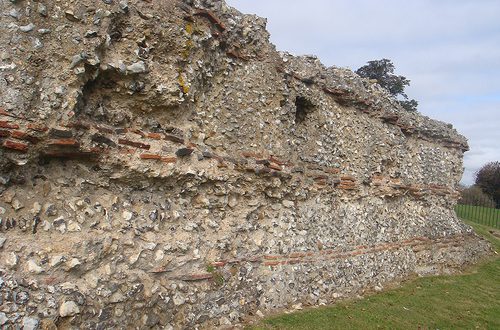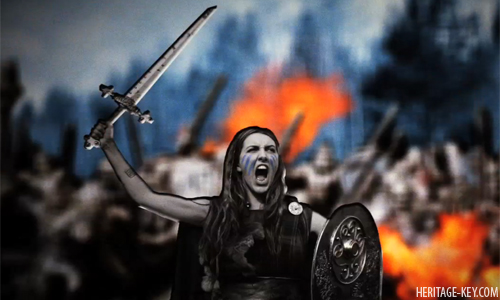 The warrior Queen, the avenging mother, the woman scorned. Ask any English person who led ‘us’ in the fight against Rome and they will tell you about a woman whose fame outweighs her achievements. Called Boadicea, Boudicca or Boudica, she has a legendary status, like Vercingetorix in Gaul, as one of the leaders of the old world who fought with courage against Rome. Hopelessly outmatched in so many ways, they represented tradition, their religions and some would say freedom against foreign oppressors. The logistical capability and military precision of the Empire meant that resistance to Roman dominance was in the most part futile. Those who succeeded were few and far between. Boudicca led a rebellion which, literally and metaphorically, set Roman Britain ablaze, but in doing so guaranteed the destruction of her people and their way of life. I want to look at who she was and why she rebelled, and ask what her legacy really was. How did this woman from almost two millenia ago cement her place in British history? What did she do to warrant a statue in Westminster, just metres from the likes of Churchill, Cromwell and Richard the Lionheart?
The warrior Queen, the avenging mother, the woman scorned. Ask any English person who led ‘us’ in the fight against Rome and they will tell you about a woman whose fame outweighs her achievements. Called Boadicea, Boudicca or Boudica, she has a legendary status, like Vercingetorix in Gaul, as one of the leaders of the old world who fought with courage against Rome. Hopelessly outmatched in so many ways, they represented tradition, their religions and some would say freedom against foreign oppressors. The logistical capability and military precision of the Empire meant that resistance to Roman dominance was in the most part futile. Those who succeeded were few and far between. Boudicca led a rebellion which, literally and metaphorically, set Roman Britain ablaze, but in doing so guaranteed the destruction of her people and their way of life. I want to look at who she was and why she rebelled, and ask what her legacy really was. How did this woman from almost two millenia ago cement her place in British history? What did she do to warrant a statue in Westminster, just metres from the likes of Churchill, Cromwell and Richard the Lionheart?
Gradual Conquest
In the middle of the first century AD Rome had swallowed up territory from North Africa to the Near East, from Spain to Romania. At its north-western corner was Gaul, and beyond that the wild and untamed expanse of Britain, which Rome would never succeed in fully mastering.
The conquest of Britain was a piecemeal and gradual process over the course of many years. The first attempts were made by Julius Caesar in 55 and 54 BC. However, neither of these were made with much conviction. Both were aborted due to trouble in Gaul, but not before Caesar had established some client states on the British mainland. It took almost a hundred years before another emperor decided to have a bash at a more complete conquest. Claudius, emperor from 41 to 54 AD, sent his general Aulus Plautius to deal with attacks on the Roman clients within Britain. At that time there were two dominant tribal peoples, the Catuvellauni, north of the Thames and the Atrebates, south of it. The Catuvellauni rulers were descended from the leaders who had fought against Julius Caesar and had a tradition of resisting Roman influence. The Atrebates on the other hand enjoyed the benefits of ties to Rome, not least because they saw the advantage of ties to Rome for their rivalry with the Catuvellauni. Verica, the Atrebati Prince, gave Claudius cause to invade when he fled to Rome after Catuvellauni invasion of his lands.
Queen Boudicca
The Romans hated her, the Celts fought for her and now she is immortalised with a statue in Westminster. But who was Boudicca? The latest video in the Ancient World in London series looks at how her name is often misspelt, how her bloodthirsty rage was caused by the death of her husband and raping of her daughters and how the Romans beat her to within an inch of her life. The story of how she sacked three Roman cities in Britain is uncovered, and how she fell at the Battle of Watling Street.
The troops who travelled into Britain under Roman colours needed to be brave, for they were travelling to the very edges of ‘the world’ as they perceived it. Four legions, including terrifying war elephants (so Cassius Dio says) headed for the Catuvellauni capital of Camulodunum (modern Colchester), skirmishing with the Catuvellauni on the way. The native resistance was not strong enough and Claudius was able to join his general to personally lead the procession into the city.
From that point onwards each year saw a gradual opportunistic expansion further and further into Britain, as more Roman forces arrived and as tribes weakened against them. By 60 AD the Romans had invaded Anglesey, an island just off North Western Wales.
The Iceni were based to the North of Camulodunum, in modern Norfolk. They had lived in alliance with the Romans until the death of their leader Prasutagus in AD 60. The Romans saw the opportunity to claim valuable land. The alliance was annulled and the lands claimed as part of Roman governed Britain. The Iceni had a choice: give in to the Roman yoke, or resist behind the new Iceni leader. That leader was Boudicca, and her rebellion won her a prominent position in English history.
Outrages
Perhaps Prasutagus had been aware of Roman eyes hungrily looking towards his kingdom, perhaps he wanted to ensure the safety of his wife and daughters. For whatever reason, he left half of his Kingdom to the Roman empire upon his death. Whether this was part of a deal with Rome we do not know. But the Romans were not satisfied with half, they wanted the whole thing. Prestagus had unrepayed loans to the Roman governors, and his lands were to be forfeited. Also, Roman law didn’t recognise the right of a woman to inherit the kingdom. From their point of view, the Iceni lands were now entirely the property of Rome, and the Iceni nobles were just slaves. They rubbed salt into the the wounds of the Iceni by whipping Boudicca and, we are told by Tacitus, raping her daughters. This cruel humiliation did not break Boudicca’s will; in fact it drove her to seek revenge. The Iceni Queen met with the leaders of the Trinovanti tribe and together they conspired to rebel, with other smaller tribes joining their coalition. Boudicca was chosen to lead the rebellion, the woman whose name meant ‘Victorious’ in the Celtic language.
Cassius Dio gives us this account of Boudicca’s appearance:
A Briton woman of the royal family and possessed of greater intelligence than often belongs to women… In stature she was very tall, in appearance most terrifying, in the glance of her eye most fierce, and her voice was harsh; a great mass of the tawniest hair fell to her hips; around her neck was a large golden necklace; and she wore a tunic of divers colours over which a thick mantle was fastened with a brooch. This was her invariable attire.”
If his description is accurate, she would have cut a striking figure as she advanced towards Camulodunum. Camulodunum had been Romanised. The army veterans who had settled there had taken native people as slaves and confiscated lands. In the city they built a Temple of Claudius – a symbol of the alien oppression. When the Romans of Camulodunum got news of the rebels coming their way they appealed to the army for help. However, the troops that were sent were no match for Boudicca’s force. The IXth Legion was routed and only a few of the cavalry survived to tell the tale. The Romans took refuge inside the temple, sentencing them to harrowing deaths as the rampant Britons set the city ablaze. The accounts we have, which may well be biased given their Roman point of view, paint a picture of a merciless foe, sparing nothing from destruction. The archaeological record backs this up – a thick layer of ash exists around two metres under the ground of Colchester to this day. Tacitus describes the fury:
The British did not take or sell prisoners, or practice war-time exchanges. They could not wait to cut throats, hang, burn, and crucify – as though avenging, in advance, the retribution that was on its way.
!["[She had] a great mass of the tawniest hair fell to her hips; around her neck was a large golden necklace" "[She had] a great mass of the tawniest hair fell to her hips; around her neck was a large golden necklace"](https://heritage-key.com/medialink/files/queen-boudicca.jpg) Dio mentions worse still: impalement of noblewomen followed by the cutting off of their breasts, human sacrifice and debauched celebrations after the massacre.
Dio mentions worse still: impalement of noblewomen followed by the cutting off of their breasts, human sacrifice and debauched celebrations after the massacre.
Boudicca’s force pushed on to their next targets, the Roman hubs at Verulamium (now St. Albans) and finally Londinium. With the bulk of the Roman force in Britain far off in Anglesey, all the colonists could do was retreat and watch the burning skies above their adopted home towns. The death toll is estimated at 70-80,000 people in these cities. This included the deaths of many non-Romans who were between the Britons and their plunder.
The Bloody Tide Turns
The Roman governor Suetonius Paulinus had been away with his forces in Angelsey, returning to London in time to flee from the rebel force, which was gathering in size like a rolling snowball. After the sacking of London Paulinus gathered together 10,000 troops and took them to an unknown location where they met the much larger rebel force. Tacitus talks of an army of 230,000, but we can take that claim with a pinch of salt as the population of the entire British mainland is estimated to have been between only 1 and 1.5 million. The Battle, called the ‘Battle of Watling Street’ as it happened somewhere along the route of that particular Roman road, had a predictable outcome.
If we compare the two armies, the differences were in more than just size. The Roman force was made up of professional soldiers equipped with weapons designed specifically to kill humans and dressed in high-tech plated body armour and helmets. The disorganised mob they faced were poorly equipped, in part due to Roman enforced de-armament of the Iceni. Their force was of men and, according to Tacitus, also women, and behind the soldiers was a crescent-shaped wagon train made up of the families who had followed their kin to the battlefield. Chariots – probably without the Persian-style bladed wheels as seen on Boudicca’s statue – circled the warriors, shooting missiles towards the Romans. The chariot has become synonymous with Boudicca.
 Suetonius Paulinus chose a location where his two sides were flanked by a gorge, and his rear protected by dense forest. Tacitus’ father-in-law was Agricola, future governor of Britannia, who fought in the battle under Paulinus, and this connection gave Tacitus special insight into what happened next. We are told Paulinus made a speech to his troops:
Suetonius Paulinus chose a location where his two sides were flanked by a gorge, and his rear protected by dense forest. Tacitus’ father-in-law was Agricola, future governor of Britannia, who fought in the battle under Paulinus, and this connection gave Tacitus special insight into what happened next. We are told Paulinus made a speech to his troops:
“Ignore the racket made by these savages. There are more women than men in their ranks. They are not soldiers – they’re not even properly equipped. We’ve beaten them before and when they see our weapons and feel our spirit, they’ll crack. Stick together. Throw the javelins, then push forward: knock them down with your shields and finish them off with your swords. Forget about booty. Once we have one we’ll take everything.”
And then Boudicca’s screaming army rushed forwards. Their first wave was met by two volleys of the Roman pilum javelins, and many of them were killed, wounded or their shields made useless. With no other tactic in her arsenal Boudicca sent wave upon wave against the Roman shield wall. The Roman spirits held against the onslaught and their tactic of shifting places in the ranks ensured the men on the front of the formation were always fresh to continue the butchery. As the Britons tired the Romans formed a tight formation of wedges, advancing into the field slowly and with crushing precision. We can imagine the horror of the onlookers amongst the British wagon train, as they saw the Romans advance and the Britons break against the gnashing teeth of the wedges. Then the cavalry charged into the wavering force. The remnants of Boudicca’s army tried to flee, but were sandwiched between the Romans and baggage train, a horrific killing field was created and the Romans spared no one. Tacitus’ appraisal was of 80,000 Britons dead, compared to only 400 Romans, although historians are sceptical of these figures.
What of Boudicca? Did she die in the battle? We do not know. Tacitus tells us she poisoned herself rather than face the terrible repercussions the Romans would have inflicted. Dio disagrees and says she fell ill and died. There is also no record of her daughters, who may have followed their mother into battle. We can imagine that Boudicca would have done all in her power to prevent them from falling into enemy hands again.
 This did not stop the reprisals. Paulinus led punitive actions against any remaining opposition, and in doing so only exacerbated relations with the populace. By this time Nero was emperor and he was concerned by Paulinus’ approach, ultimately replacing him with a more amicable governor.
This did not stop the reprisals. Paulinus led punitive actions against any remaining opposition, and in doing so only exacerbated relations with the populace. By this time Nero was emperor and he was concerned by Paulinus’ approach, ultimately replacing him with a more amicable governor.
Boudicca’s rebellion had cost perhaps as many as 100,000 lives by the time the last strike fell in anger (my own estimate based on more conservative versions of the Roman figures). She had destroyed the lives of many inhabitants of her former kingdom and weakened the other tribes in her coalition. In battle she had been nave and this ultimately seems to have cost her her life and maybe also those of her daughters. Subjected to cruelty herself, in her rage she perpetuated the cycle of violence and it seems did so without a great deal of discrimination between Roman and Briton. As a result she justified Paulinus’ own crackdown.
Her rebellion was absent from history until its rediscovery during the Renaissance. If archaeologists were ever to find her burial place it would be perhaps the greatest find yet in the British isles, as she is intertwined with Victorian nationalism. Queen Victoria was called the (metaphorical) reincarnation of Boudicca, and the romanticised image of the Celtic queen sprung a life of its own. The anti-imperialist became a heroine of a new empire claiming dominion of other far-off lands, a final twist of irony in the tale of Boudicca.






